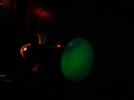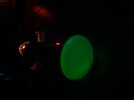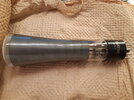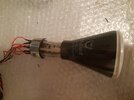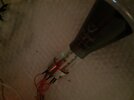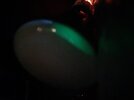I have a 2AP1 CRT (datasheet attached) that I wish to use to make an oscilloscope eventually. The CRT was bought off Ebay and may potentially be faulty although the seller claimed that the CRT was fully functional. The main issue I am having is that I cannot get the beam to focus at all. To make sense of the following information, please note that I have the grid connected to 0v and that the cathode is positive with respect to the grid. I did this to avoid needing a split supply.
Here are the DC voltages across the various electrodes, all referenced to the grid:
Cathode: 0v (the screen is completely invisible at 20v)
Anode 1: 200v (varying this from 80v to 540v seems to change the focus somewhat but there is nothing vaguely resembling a dot. See image 2)
Anode 2: 1kV
D1: 40v (Adjusting this seems to help make the shape on the screen more focused to some extent)
D2: 0v
D3: 20v (at 80v the beam is completely prevented from reaching the screen and the screen becomes dark)
D4: 0v
Heater (separate supply, not referenced to grid): roughly 6.3v DC
The issue is that I cannot get anything vaguely resembling a dot. I don't know if my adjustments are correct because I just see a giant blob on the screen and all I can tell when I twist the knobs on my supplies is that something is changing.
An additional issue is that the screen is pretty dim. I initially had A2 at around 500v and thought that was the reason it was dim so I brought in my other supply which goes up to a higher voltage and set it to 1kV which did help but not the extent I thought it would. It might look bright in the pictures attached but that is in near complete darkness; in a well-lit room I can hardly tell that the display is on.
Here are the DC voltages across the various electrodes, all referenced to the grid:
Cathode: 0v (the screen is completely invisible at 20v)
Anode 1: 200v (varying this from 80v to 540v seems to change the focus somewhat but there is nothing vaguely resembling a dot. See image 2)
Anode 2: 1kV
D1: 40v (Adjusting this seems to help make the shape on the screen more focused to some extent)
D2: 0v
D3: 20v (at 80v the beam is completely prevented from reaching the screen and the screen becomes dark)
D4: 0v
Heater (separate supply, not referenced to grid): roughly 6.3v DC
The issue is that I cannot get anything vaguely resembling a dot. I don't know if my adjustments are correct because I just see a giant blob on the screen and all I can tell when I twist the knobs on my supplies is that something is changing.
An additional issue is that the screen is pretty dim. I initially had A2 at around 500v and thought that was the reason it was dim so I brought in my other supply which goes up to a higher voltage and set it to 1kV which did help but not the extent I thought it would. It might look bright in the pictures attached but that is in near complete darkness; in a well-lit room I can hardly tell that the display is on.

